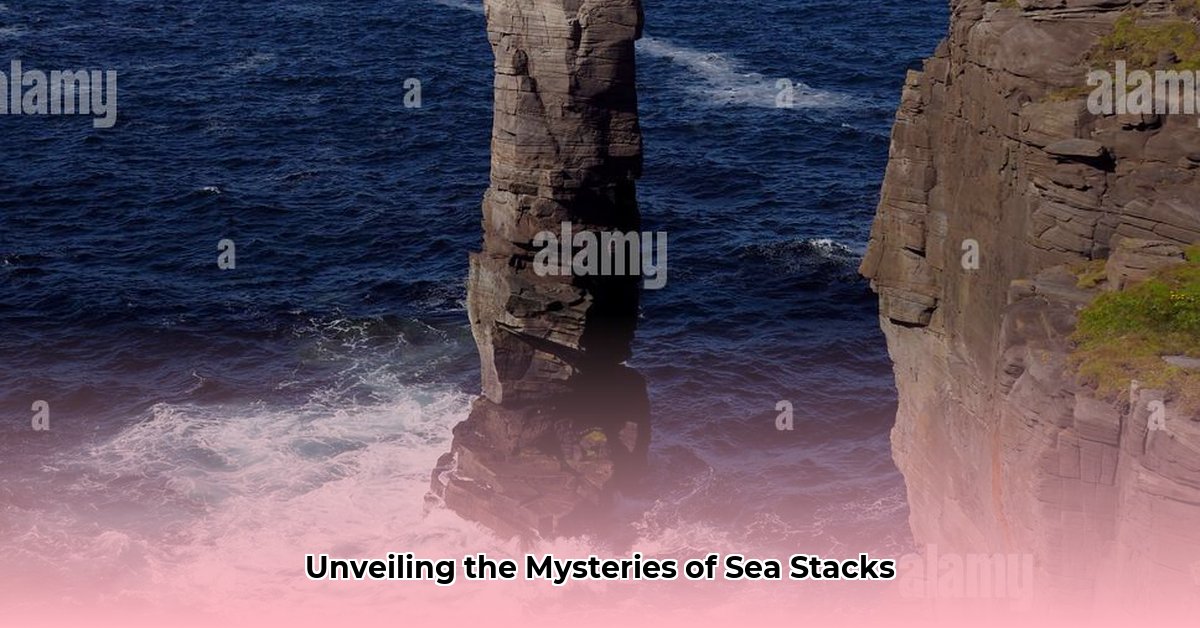The Making of a Coastal Icon
Picture this: a solitary spire of rock, rising defiantly from the churning ocean, enduring the relentless onslaught of waves. This is a sea stack, a testament to the raw power of nature and the slow, persistent forces of erosion. This guide unveils the fascinating geological journey of sea stacks, from their origins in coastal headlands to their eventual demise.
How Sea Stacks Are Formed: A Step-by-Step Guide
Sea stacks don’t just appear overnight. Their formation is a dramatic, multi-stage process spanning millennia, sculpted by the tireless work of wind and waves.
-
Headland Assault: The story begins with a humble headland, a protrusion of land extending into the sea. Relentless waves, driven by wind and tides, begin their assault, exploiting any weaknesses in the rock—cracks, fissures, or softer sections.
-
Cave Creation: Over time, the constant pounding of waves carves caves into the headland’s vulnerable spots. Like a sculptor chipping away at stone, the ocean slowly but surely hollows out the rock face.
-
Arch Emergence: As erosion progresses, these caves may eventually pierce right through the headland, forming a magnificent natural arch. This temporary bridge stands as a testament to the ocean’s persistent power.
-
Stack Formation: Weakened by the ceaseless waves and gravity’s pull, the arch eventually collapses, leaving behind an isolated pillar of rock—the sea stack. This solitary sentinel stands as a monument to the ocean’s tireless work.
-
Stump Degradation: Even the mighty sea stack isn’t invincible. Over time, erosion continues its relentless work, gradually wearing down the stack until it becomes a low-lying rock platform, or stump, barely visible above the waves.
The Role of Rock Type
The type of rock significantly influences a sea stack’s shape and lifespan. Harder rocks, like granite and basalt, resist erosion, resulting in towering, dramatic stacks. Softer rocks, such as sandstone and chalk, erode more readily, leading to smoother, rounded profiles and a shorter lifespan.
| Rock Type | Erosion Rate | Typical Sea Stack Shape |
|---|---|---|
| Granite | Slow | Steep, jagged, imposing |
| Basalt | Moderate | Columnar, often hexagonal, dramatic |
| Sandstone | Moderate | Rounded, smooth, sculpted |
| Chalk | Fast | Irregular, ever-changing, delicate |
Famous Sea Stacks: A Global Showcase
Sea stacks grace coastlines worldwide, each with a unique geological story to tell.
-
The Twelve Apostles, Australia: These majestic limestone remnants, rising from the Southern Ocean, are a testament to the power of coastal erosion. Their numbers dwindle over time, a stark reminder of the ongoing process.
-
Old Harry Rocks, UK: These striking chalk formations on the Dorset coast offer a dynamic display of erosion in action. Their fragile nature suggests a landscape in perpetual motion.
-
Giant’s Causeway, Northern Ireland: This otherworldly landscape boasts thousands of interlocking basalt columns, a dramatic result of volcanic activity and subsequent erosion.
[Add other famous examples, including Dun Briste, Sail Rock, Old Man of Hoy, Risin og Kellingin, Ko Tapu, Ball’s Pyramid, Kicker Rock, Lange Anna, and Tri Brata with brief descriptions and relevant links if available. Consider embedding a map showcasing their global distribution.]
Sea Stacks and Climate Change: An Uncertain Future
Climate change, marked by rising sea levels and more frequent, intense storms, poses a significant threat to sea stacks. Increased wave action at their bases, coupled with changes in wave patterns, is accelerating erosion. Ocean acidification, caused by increased carbon dioxide absorption, further weakens the rock, making sea stacks more vulnerable.
| Climate Change Factor | Impact on Sea Stacks |
|---|---|
| Rising Sea Levels | Increased wave action at the base |
| More Intense Storms | Higher wave energy and storm surges |
| Shifting Wave Patterns | Erosion from new angles |
| Ocean Acidification | Weakening of rock structure |
The future of sea stacks remains uncertain. While some researchers suggest that more resistant rock types may withstand the increased pressures, ongoing research is crucial to understanding the long-term impacts of climate change and developing potential conservation strategies. Some scientists believe that accelerated erosion may lead to the loss of some of these iconic landmarks. Others are exploring how changes in wave patterns might affect sea stack formation and longevity. This area requires further study to fully comprehend the complex interactions at play.
Erosion Processes: A Closer Look
The formation of sea stacks involves a complex interplay of erosional forces:
-
Hydraulic Action: The sheer force of waves crashing against the rock compresses air within cracks and crevices. As the waves recede, the compressed air expands explosively, widening the cracks and weakening the rock.
-
Abrasion: Waves armed with sand, pebbles, and even larger rock fragments act like sandpaper, grinding away at the headland.
-
Corrosion: Seawater, slightly acidic, can dissolve certain rock types, particularly those containing calcium carbonate, such as limestone and chalk.
-
Attrition: The constant collision of rock fragments carried by waves gradually breaks them down into smaller pieces, further contributing to the abrasive action.
Conclusion
Sea stacks are more than just picturesque coastal features; they are dynamic geological formations, constantly evolving in response to the relentless forces of nature. Understanding their creation, composition, and the threats they face allows us to appreciate their significance and the need for their preservation in a changing world. Further exploration into the impact of climate change, combined with ongoing monitoring, will be crucial to protecting these captivating coastal icons for future generations.
- Hydro Extrusions USA Leads North American Aluminum Profile Solutions - December 28, 2025
- Hydro North America Leads Aluminum Extrusion Solutions Across Diverse Industries - December 27, 2025
- Hydro Extrusion North America Provides Custom Solutions Across Diverse - December 26, 2025
















